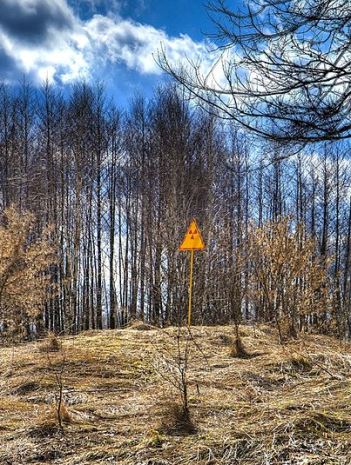
We have written several times about the very unique fire risk around the Chernobyl nuclear plant that melted down in 1986. The forest and towns around it have been designated as the Chernobyl Exclusion Zone, the 30 Kilometer Zone, or the Chernobyl Zone of Alienation. If a wildfire breaks out in the area it could expose firefighters to high levels of radiation, as well as residents downwind of the fire.
Motherboard has an article that provides additional information about how dead vegetation in the zone is decaying much more slowly than normal organic material. Below are some excerpts from the article:
…The forests around Chernobyl—the nuclear power plant that exploded 28 years ago—are not decaying properly and should it all catch fire, radioactive material would spread beyond Chernobyl’s Zone of Alienation, the off-limits 1000 square-miles around the decommissioned facility located 68 miles north of Kiev.
This Zone of Alienation has given environmental scientists much to study, withinsects choosing to not live there and the birds that do live there developing abnormalities like deformed beaks, odd tail feather lengths, and smaller brains. The trees too, have been shady.
Scientists who have been studying the environment inside the Zone of Alienation since 1991 noticed something about these trees, specifically what they described as “a significant accumulation of litter over time” in a study published recently in Oecologia. And by “significant,” they mean the trees are not decomposing and their leaves are just sitting there on the ground, not decomposing either.
The reason for this lack of decay around Chernobyl is that microbes, bacteria, fungi, worms, insects, and other living organisms known as decomposers (because they feed on dead organisms) are just not there and not doing their jobs. Mousseau and his team discovered this after leaving 600 bags of leaves around Chernobyl in 2007. When they collected the bags in 2008, they found that the bags filled with leaves placed in areas with no radiation had decomposed by 70 to 90 percent, but the leaves in areas with radiation? They only decomposed about 40 percent. “There is growing concern that there could be a catastrophic fire in the coming years,” Mousseau told Smithsonian.
There are firefighters stationed around the Zone of Alienation specifically for preventing a forest fire inside, but they’re “obviously not prepared for a major wildfire situation” says SA, with hardly any “professional training, protective suits or breathing apparatuses.” Firefighters currently scout for fires by climbing six watch towers a day, along with the help of one helicopter that is “occasionally available.” They do have a Soviet tank that has been retrofitted with a 20-foot-blade though, to chop down and crush the dead trees that refuse to decay currently littering the roadways.

Not too surprising I guess.
It’s, to some extent, the same in every plot of land that is being chemically farmed – where soil microbiology has been killed. Most folks haven’t a clue how important those unseen microbial life and visible insects and worms are to the land’s health.
This was an article about some Oregon loggers that were going to log this to help minimize the problem. I wonder what came of that?
http://www.opb.org/news/article/oregon-loggers-eye-role-near-chernobyl/